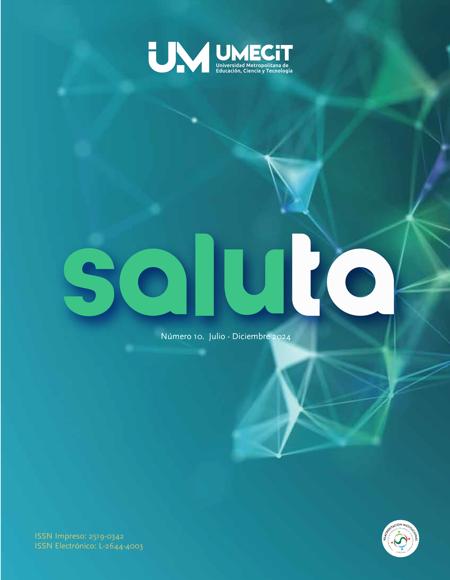Manuscripts sent to SALUTA Magazine must be original and unpublished and must not be simultaneously in the process of publication in other magazines, compilations or any other means of publication. The content of the publications and the links suggested in them are the sole responsibility of the authors and not of the METROPOLITAN UNIVERSITY OF EDUCATION, SCIENCE AND TECHNOLOGY
(UMECIT) or the magazine SALUTA. They are protected by international copyright laws as well as the logos of UMECIT AND SALUTA MAGAZINE, hence their reproduction is totally prohibited. The copyright will belong to the UMECIT.
Under a Creative Commons Attribution License authors may share work with acknowledgment of authorship of the work and initial publication in this journal.



Abstract
Testosterone is a metabolic and vascular hormone with multiple physiological effects in various tissues of the body. The decrease in the serum level of testosterone triggers a reduction in bone mass, cardiovascular diseases and osteoporosis, having an implication on the bone structure, with older adults being the ones who suffer from it most frequently 1,2. The objective of the present investigation was to determine the relationship between testosterone and mandibular alveolar bone in patients between 60 and 80 years old from the Faculty of Dentistry of the National University Federico Villarreal. As a methodology, an observational, descriptive and cross-sectional study was carried out at the Dental Clinic of the National University Federico Villarreal, in the period from January to June 2023. The statistical test of the Pearson correlation coefficient was used. The level of significance was (p < 0.05). The results indicate that there is a positive correlation between the testosterone dosage and the mandibular panoramic index; 45% of the study population has testosterone values below 3.25, presenting a high risk of developing osteoporosis. It is concluded that there is a correlation between testosterone and the mandibular panoramic index and patients with low testosterone levels have a high risk of developing osteoporosis with alveolar bone involvement.
References
Kiswanjaya, B., Priaminiarti, M., & Bachtiar-Iskandar, H. H. (2022). Three panoramic indices for identification of healthy older people at a high risk of osteoporosis. The Saudi Dental Journal, 34(6), 503-508. https://doi.org/10.1016/j.sdentj [16]
Bras, J., et al. (1985). Radiographic interpretation of the mandibular angular cortex: A diagnostic tool in metabolic bone loss. Part II. Renal osteodystrophy. Oral Surgery, Oral Medicine, Oral Pathology, 53(6), 47-50. Disponible en: https://pubmed.ncbi.nlm.nih.gov/12424634/'>https://pubmed.ncbi.nlm.nih.gov/12424634/ [4]
Cakur, B., Dagistan, S., Sahin, A., Harorli, A., & Yilmaz, A. B. (2009). Reliability of mandibular cortical index and mandibular bone mineral density in the detection of osteoporotic women. Dentomaxillofacial Radiology, 38, 255. [17]
Calciolari, E., Donos, N., Park, J. C., Petrie, A., & Mardas, N. (2014). Panoramic measures for oral bone mass in detecting osteoporosis: A systematic review and meta-analysis. Journal of Dental Research. Disponible en: https://pubmed.ncbi.nlm.nih.gov/25365969/ [14]
Cannarella, R., Barbagallo, F., Condorelli, R. A., Aversa, A., La Vignera, S., & Calogero, A. E. (2019). Osteoporosis desde una perspectiva endocrina: El papel de los cambios hormonales en las personas mayores. Journal of Clinical Medicine, 10, 1564. https://doi.org/10.3390/jcm8101564 [15]
Drozdzowska, B., Pluskiewicz, W., & Tarnawska, B. (2002). Panoramic-based mandibular indices in relation to mandibular bone mineral density and skeletal status assessed by dual energy X-ray absorptiometry and quantitative ultrasound. Dentomaxillofacial Radiology, 31, 361-367. Disponible en: https://pubmed.ncbi.nlm.nih.gov/12424634/'>https://pubmed.ncbi.nlm.nih.gov/12424634/ [5]
Eller-Vainicher, A., Falchetti, L., & Gennari, L. (2019). Diagnóstico de enfermedad endocrina: Evaluación de la fragilidad ósea en trastornos endocrinos. Journal of Endocrinology, 180(6), R213-R232. Disponible en: http://www.scielo.org.mx/scielo.php?script=sci_arttext&pid=S0026-17422017000400045 [9]
Kellesarian, S. V., Malmstrom, H., & Abduljabbar, T. (2017). Los niveles bajos de testosterona en los fluidos corporales están asociados con la periodontitis crónica: ¿Una realidad o un mito? American Journal of Men's Health, 11(2), 443-453. https://doi.org/10.1177/1557988316667692 [8]
Klemetti, E., & Kolmakow, S. (1997). Morphology of the mandibular cortex on panoramic radiographs as an indicator of bone quality. Dentomaxillofacial Radiology, 26, 22-25. Disponible en: https://pubmed.ncbi.nlm.nih.gov/9446986/ [20]
Lee, Y. K., Lee, Y. J., Ha, Y. C., & Koo, K. H. (2014). Five-year relative survival of patients with osteoporotic hip fracture. Journal of Clinical Endocrinology & Metabolism, 99, 97–100. Disponible en: https://pubmed.ncbi.nlm.nih.gov/24203068 [6]
López, J. (2012). Diagnóstico precoz de la osteoporosis mediante ortopantomografía y radiografías orales. Revista Medicina Oral, Patología Oral y Cirugía Bucal, 17(1), 13-21. Disponible en: https://dialnet.unirioja.es/servlet/articulo?codigo=3811236 [12]
Manolagas, S. C. (2000). Birth and death of bone cells: Basic regulatory mechanisms and implications for the pathogenesis and treatment of osteoporosis. Endocrine Reviews, 21, 115-137. Disponible en: https://pubmed.ncbi.nlm.nih.gov/10782361/ [3]
Med Oral Patol Oral Cir Bucal. (2011). Disponible en: https://pubmed.ncbi.nlm.nih.gov/21743400/ [18]
Morales, A., Heaton, J. P. W., & Carson, C. C. (2000). Andropause: A misnomer for a true clinical entity. Journal of Urology, 163, 706-712. Disponible en: https://pubmed.ncbi.nlm.nih.gov/10687961/ [1]
Reis, C. L. B., Guerra, K. C. C., Ramírez, I., Madalena, I. R., de Almeida, A. C. P., & de Oliveira, D. S. B. (2021). La supresión de los niveles de testosterona tiene algún impacto en el crecimiento craneofacial, una revisión sistemática en estudios con animales. Journal of Clinical Medicine, 7(7), 75630-75648. Disponible en: https://dialnet.unirioja.es/servlet/articulo?codigo=7034900 [19]
Saad, F., Röhrig, G., von Haehling, S., & Traish, A. (2017). Testosterone deficiency and testosterone treatment in older men. Gerontology, 63, 144-156. https://doi.org/10.1159/000452499 [7]
Salam, R., Singh, A., & Keisam, R. (2012). Testosterone and metabolic syndrome. Indian Journal of Endocrinology and Metabolism, 16(1), 12-19. https://www.ncbi.nlm.nih.gov/pmc/articles/PMC3354945/ [2]
Stafne, E., et al. (1988). Diagnóstico radiológico en odontología (5ª ed.). Traducción: Irma Lorenzo. Argentina: Médica Panamericana. pp. 290-291. Disponible en: https://catalogosiidca.csuca.org/Record/UES.76167/Details [11]
Winck, M., Licks, R., & Camargo, V. (2008). Comparação de índices morfométricos obtidos na radiografia odontológica panorâmica na identificação de indivíduos com osteoporose/osteopenia. Radiologia Brasileira, 41(3), 183-187. Disponible en: https://www.scielo.br/j/rb/a/x5kBtzp3L5jxt8ddxphBctk/ [13]
Downloads
Publication Facts
Reviewer profiles N/A
Author statements
- Academic society
- Universidad Metropolitana de Educación, Ciencia y Tecnología
- Publisher
- Universidad Metropolitana de Educación, Ciencia y Tecnología



















